Nursing Research for Evidence-based Practice
VerifiedAdded on 2022/08/11
|14
|2170
|21
AI Summary
question i s already there have to just fill templete question related to article 4 reference s you have to write one articles in one templete one in each in four templete
Contribute Materials
Your contribution can guide someone’s learning journey. Share your
documents today.
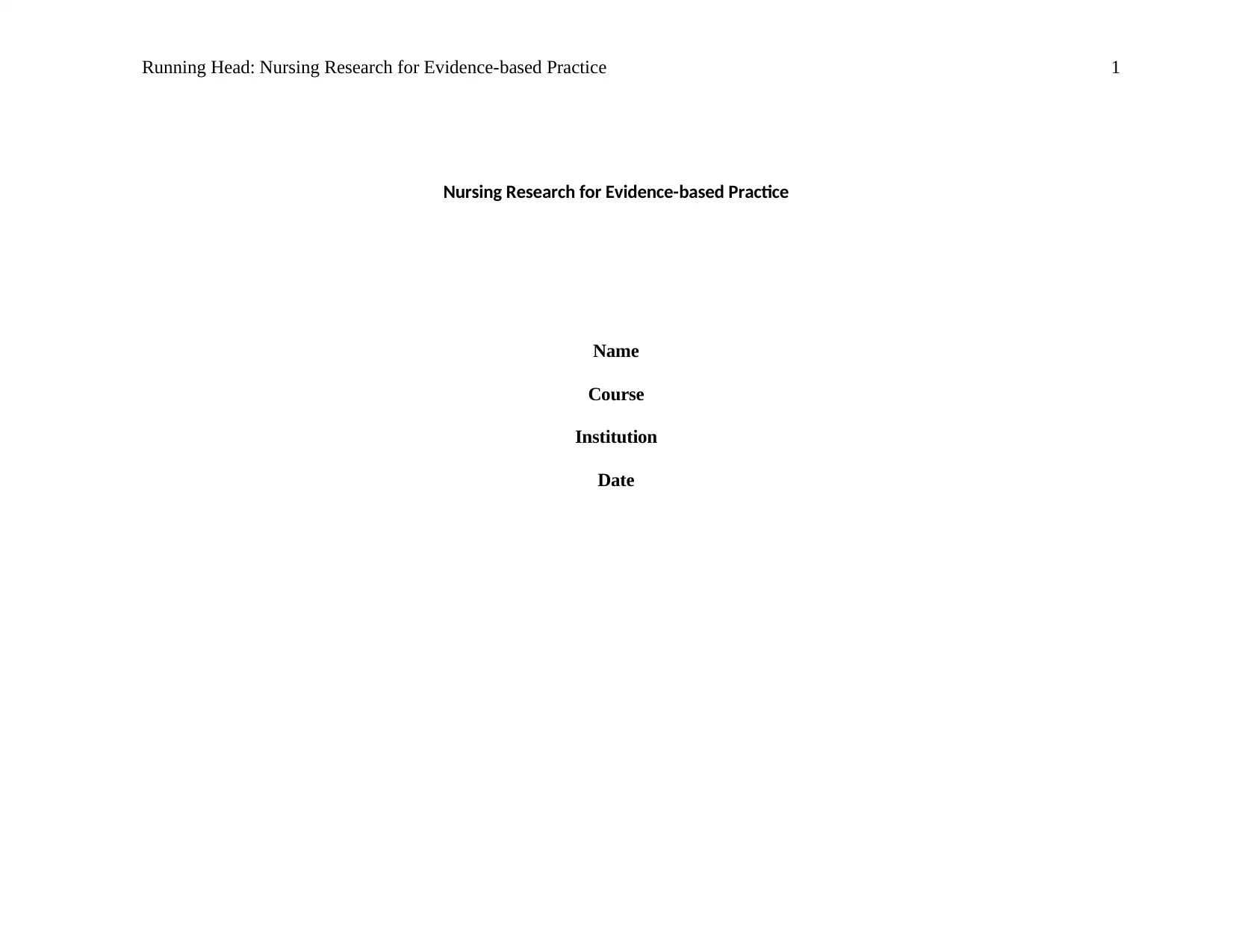
Running Head: Nursing Research for Evidence-based Practice 1
Nursing Research for Evidence-based Practice
Name
Course
Institution
Date
Nursing Research for Evidence-based Practice
Name
Course
Institution
Date
Secure Best Marks with AI Grader
Need help grading? Try our AI Grader for instant feedback on your assignments.
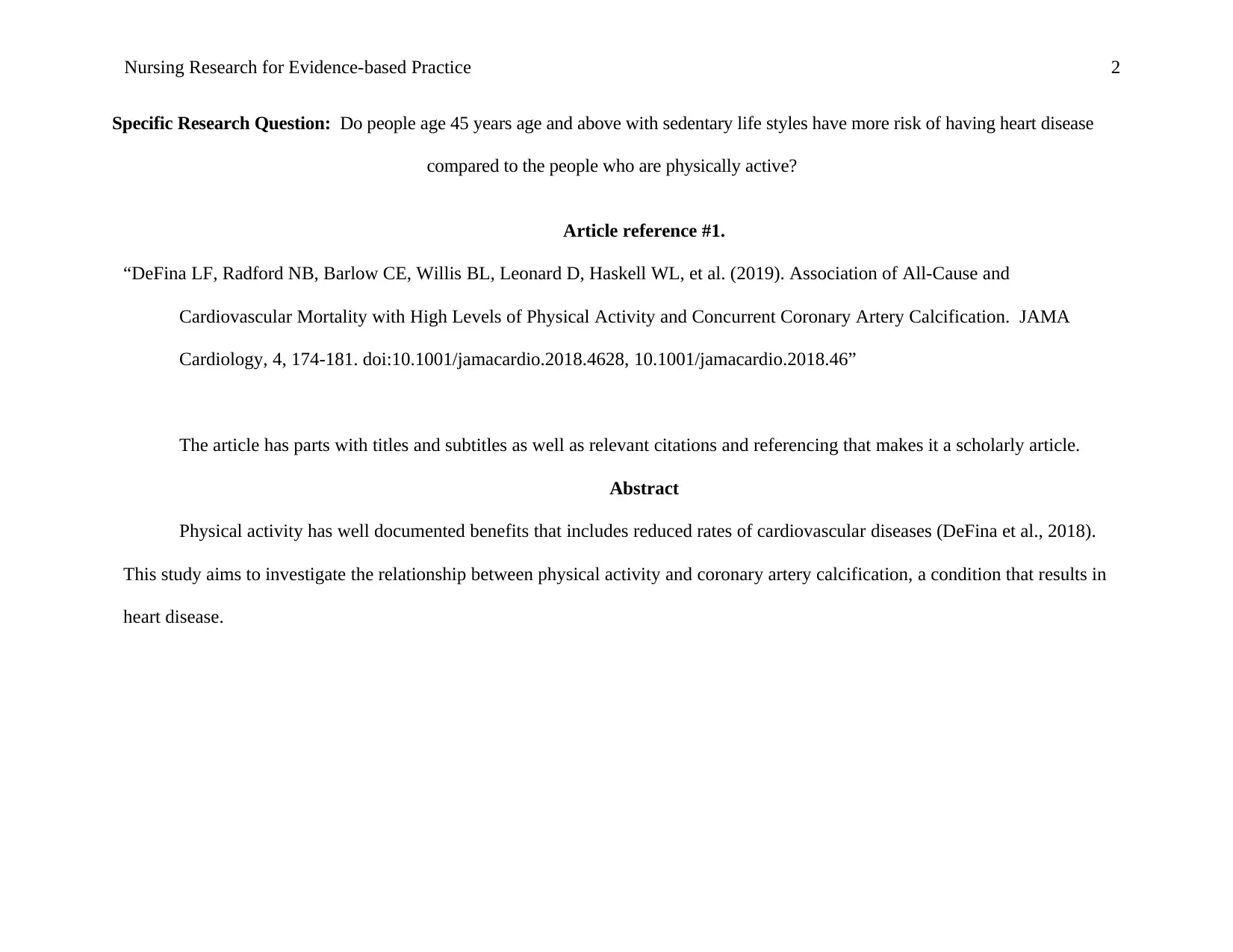
Nursing Research for Evidence-based Practice 2
Specific Research Question: Do people age 45 years age and above with sedentary life styles have more risk of having heart disease
compared to the people who are physically active?
Article reference #1.
“DeFina LF, Radford NB, Barlow CE, Willis BL, Leonard D, Haskell WL, et al. (2019). Association of All-Cause and
Cardiovascular Mortality with High Levels of Physical Activity and Concurrent Coronary Artery Calcification. JAMA
Cardiology, 4, 174-181. doi:10.1001/jamacardio.2018.4628, 10.1001/jamacardio.2018.46”
The article has parts with titles and subtitles as well as relevant citations and referencing that makes it a scholarly article.
Abstract
Physical activity has well documented benefits that includes reduced rates of cardiovascular diseases (DeFina et al., 2018).
This study aims to investigate the relationship between physical activity and coronary artery calcification, a condition that results in
heart disease.
Specific Research Question: Do people age 45 years age and above with sedentary life styles have more risk of having heart disease
compared to the people who are physically active?
Article reference #1.
“DeFina LF, Radford NB, Barlow CE, Willis BL, Leonard D, Haskell WL, et al. (2019). Association of All-Cause and
Cardiovascular Mortality with High Levels of Physical Activity and Concurrent Coronary Artery Calcification. JAMA
Cardiology, 4, 174-181. doi:10.1001/jamacardio.2018.4628, 10.1001/jamacardio.2018.46”
The article has parts with titles and subtitles as well as relevant citations and referencing that makes it a scholarly article.
Abstract
Physical activity has well documented benefits that includes reduced rates of cardiovascular diseases (DeFina et al., 2018).
This study aims to investigate the relationship between physical activity and coronary artery calcification, a condition that results in
heart disease.
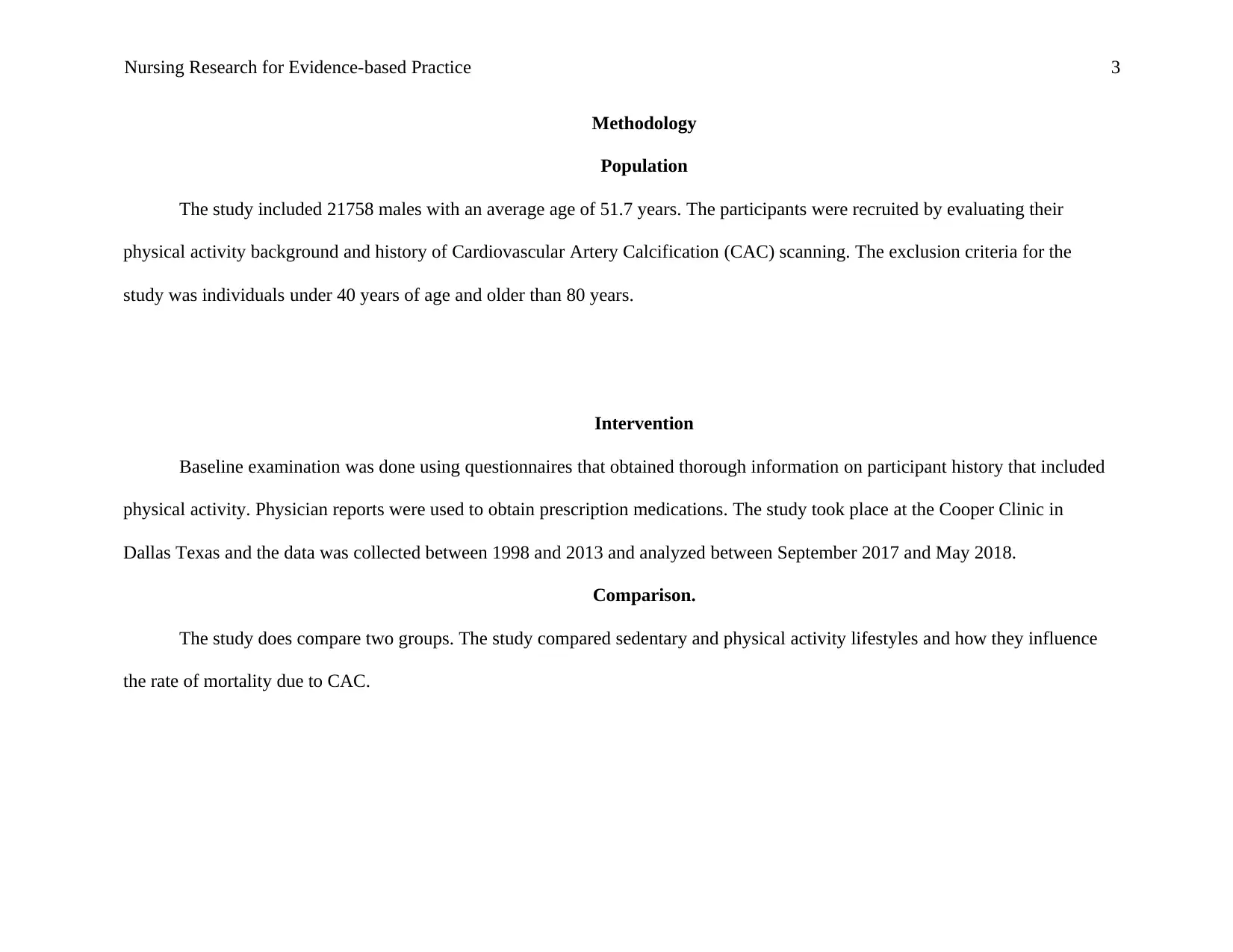
Nursing Research for Evidence-based Practice 3
Methodology
Population
The study included 21758 males with an average age of 51.7 years. The participants were recruited by evaluating their
physical activity background and history of Cardiovascular Artery Calcification (CAC) scanning. The exclusion criteria for the
study was individuals under 40 years of age and older than 80 years.
Intervention
Baseline examination was done using questionnaires that obtained thorough information on participant history that included
physical activity. Physician reports were used to obtain prescription medications. The study took place at the Cooper Clinic in
Dallas Texas and the data was collected between 1998 and 2013 and analyzed between September 2017 and May 2018.
Comparison.
The study does compare two groups. The study compared sedentary and physical activity lifestyles and how they influence
the rate of mortality due to CAC.
Methodology
Population
The study included 21758 males with an average age of 51.7 years. The participants were recruited by evaluating their
physical activity background and history of Cardiovascular Artery Calcification (CAC) scanning. The exclusion criteria for the
study was individuals under 40 years of age and older than 80 years.
Intervention
Baseline examination was done using questionnaires that obtained thorough information on participant history that included
physical activity. Physician reports were used to obtain prescription medications. The study took place at the Cooper Clinic in
Dallas Texas and the data was collected between 1998 and 2013 and analyzed between September 2017 and May 2018.
Comparison.
The study does compare two groups. The study compared sedentary and physical activity lifestyles and how they influence
the rate of mortality due to CAC.
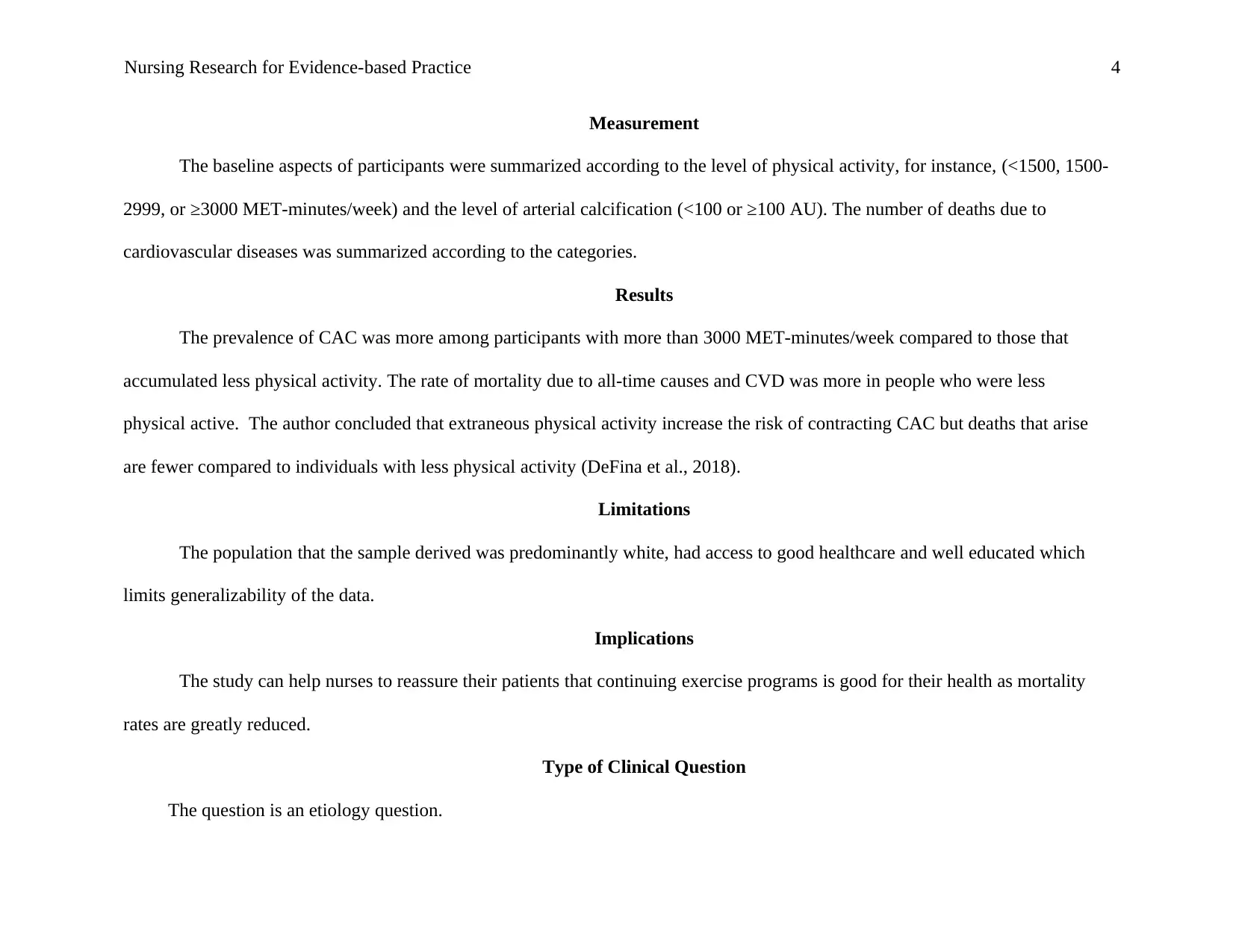
Nursing Research for Evidence-based Practice 4
Measurement
The baseline aspects of participants were summarized according to the level of physical activity, for instance, (<1500, 1500-
2999, or ≥3000 MET-minutes/week) and the level of arterial calcification (<100 or ≥100 AU). The number of deaths due to
cardiovascular diseases was summarized according to the categories.
Results
The prevalence of CAC was more among participants with more than 3000 MET-minutes/week compared to those that
accumulated less physical activity. The rate of mortality due to all-time causes and CVD was more in people who were less
physical active. The author concluded that extraneous physical activity increase the risk of contracting CAC but deaths that arise
are fewer compared to individuals with less physical activity (DeFina et al., 2018).
Limitations
The population that the sample derived was predominantly white, had access to good healthcare and well educated which
limits generalizability of the data.
Implications
The study can help nurses to reassure their patients that continuing exercise programs is good for their health as mortality
rates are greatly reduced.
Type of Clinical Question
The question is an etiology question.
Measurement
The baseline aspects of participants were summarized according to the level of physical activity, for instance, (<1500, 1500-
2999, or ≥3000 MET-minutes/week) and the level of arterial calcification (<100 or ≥100 AU). The number of deaths due to
cardiovascular diseases was summarized according to the categories.
Results
The prevalence of CAC was more among participants with more than 3000 MET-minutes/week compared to those that
accumulated less physical activity. The rate of mortality due to all-time causes and CVD was more in people who were less
physical active. The author concluded that extraneous physical activity increase the risk of contracting CAC but deaths that arise
are fewer compared to individuals with less physical activity (DeFina et al., 2018).
Limitations
The population that the sample derived was predominantly white, had access to good healthcare and well educated which
limits generalizability of the data.
Implications
The study can help nurses to reassure their patients that continuing exercise programs is good for their health as mortality
rates are greatly reduced.
Type of Clinical Question
The question is an etiology question.
Secure Best Marks with AI Grader
Need help grading? Try our AI Grader for instant feedback on your assignments.
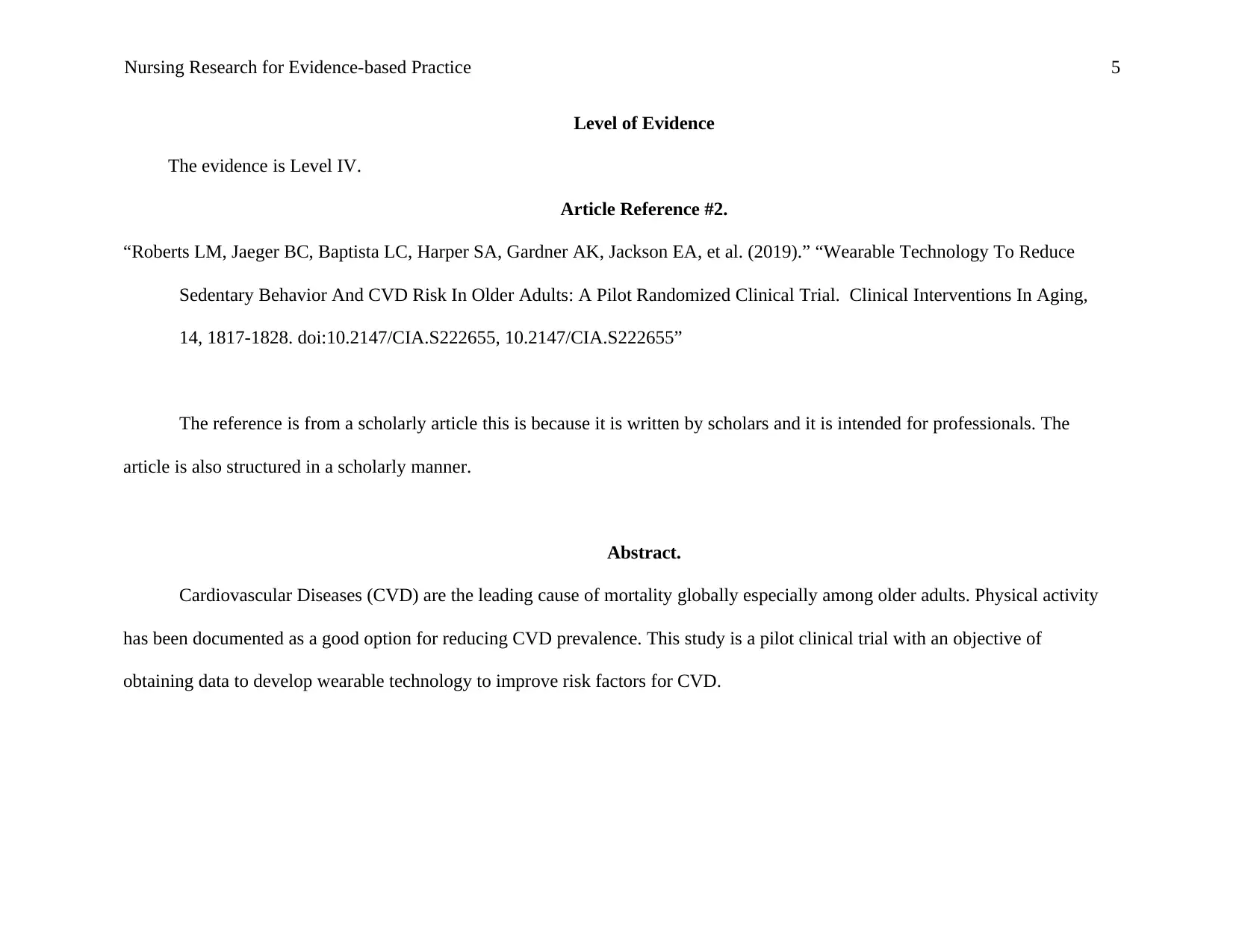
Nursing Research for Evidence-based Practice 5
Level of Evidence
The evidence is Level IV.
Article Reference #2.
“Roberts LM, Jaeger BC, Baptista LC, Harper SA, Gardner AK, Jackson EA, et al. (2019).” “Wearable Technology To Reduce
Sedentary Behavior And CVD Risk In Older Adults: A Pilot Randomized Clinical Trial. Clinical Interventions In Aging,
14, 1817-1828. doi:10.2147/CIA.S222655, 10.2147/CIA.S222655”
The reference is from a scholarly article this is because it is written by scholars and it is intended for professionals. The
article is also structured in a scholarly manner.
Abstract.
Cardiovascular Diseases (CVD) are the leading cause of mortality globally especially among older adults. Physical activity
has been documented as a good option for reducing CVD prevalence. This study is a pilot clinical trial with an objective of
obtaining data to develop wearable technology to improve risk factors for CVD.
Level of Evidence
The evidence is Level IV.
Article Reference #2.
“Roberts LM, Jaeger BC, Baptista LC, Harper SA, Gardner AK, Jackson EA, et al. (2019).” “Wearable Technology To Reduce
Sedentary Behavior And CVD Risk In Older Adults: A Pilot Randomized Clinical Trial. Clinical Interventions In Aging,
14, 1817-1828. doi:10.2147/CIA.S222655, 10.2147/CIA.S222655”
The reference is from a scholarly article this is because it is written by scholars and it is intended for professionals. The
article is also structured in a scholarly manner.
Abstract.
Cardiovascular Diseases (CVD) are the leading cause of mortality globally especially among older adults. Physical activity
has been documented as a good option for reducing CVD prevalence. This study is a pilot clinical trial with an objective of
obtaining data to develop wearable technology to improve risk factors for CVD.
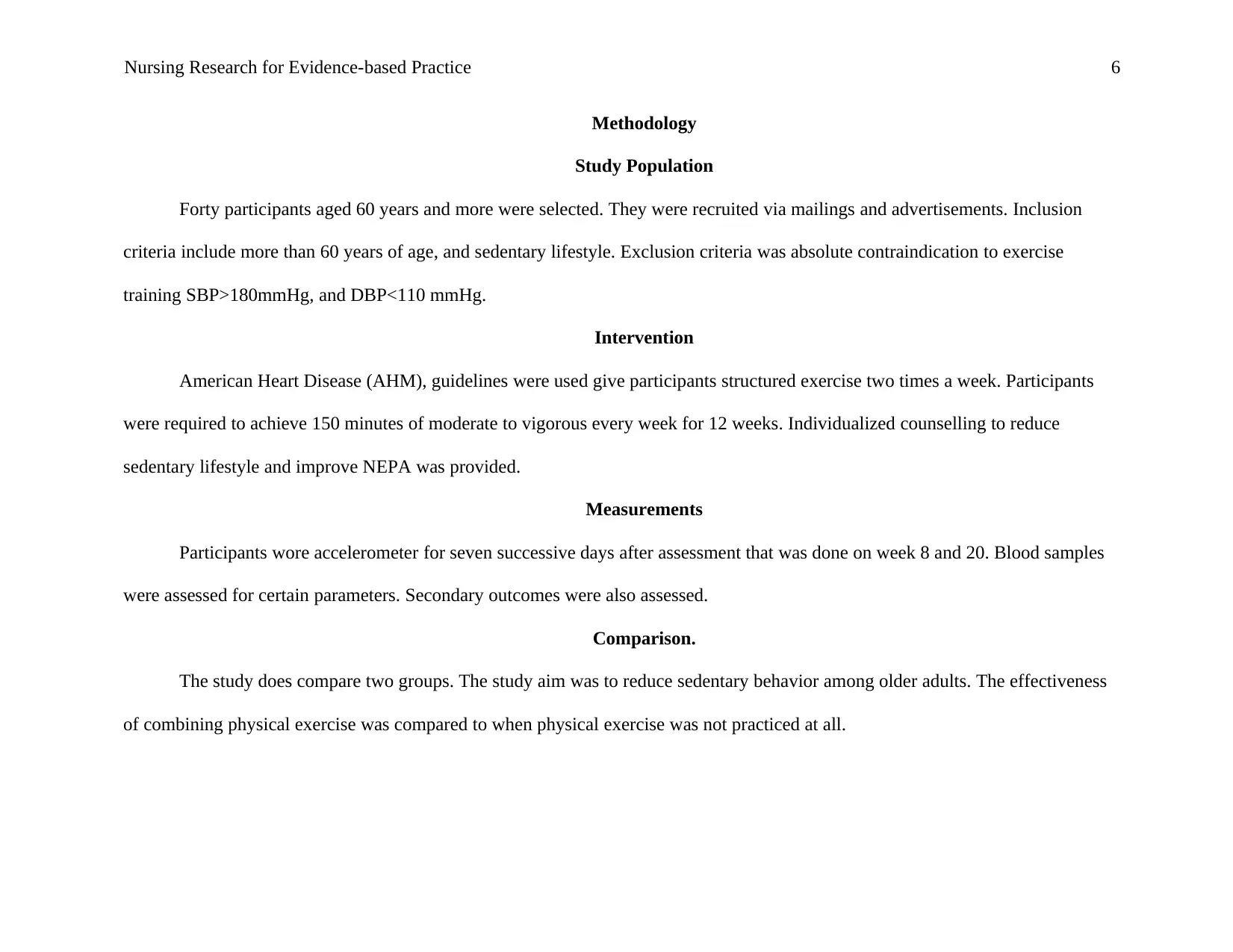
Nursing Research for Evidence-based Practice 6
Methodology
Study Population
Forty participants aged 60 years and more were selected. They were recruited via mailings and advertisements. Inclusion
criteria include more than 60 years of age, and sedentary lifestyle. Exclusion criteria was absolute contraindication to exercise
training SBP>180mmHg, and DBP<110 mmHg.
Intervention
American Heart Disease (AHM), guidelines were used give participants structured exercise two times a week. Participants
were required to achieve 150 minutes of moderate to vigorous every week for 12 weeks. Individualized counselling to reduce
sedentary lifestyle and improve NEPA was provided.
Measurements
Participants wore accelerometer for seven successive days after assessment that was done on week 8 and 20. Blood samples
were assessed for certain parameters. Secondary outcomes were also assessed.
Comparison.
The study does compare two groups. The study aim was to reduce sedentary behavior among older adults. The effectiveness
of combining physical exercise was compared to when physical exercise was not practiced at all.
Methodology
Study Population
Forty participants aged 60 years and more were selected. They were recruited via mailings and advertisements. Inclusion
criteria include more than 60 years of age, and sedentary lifestyle. Exclusion criteria was absolute contraindication to exercise
training SBP>180mmHg, and DBP<110 mmHg.
Intervention
American Heart Disease (AHM), guidelines were used give participants structured exercise two times a week. Participants
were required to achieve 150 minutes of moderate to vigorous every week for 12 weeks. Individualized counselling to reduce
sedentary lifestyle and improve NEPA was provided.
Measurements
Participants wore accelerometer for seven successive days after assessment that was done on week 8 and 20. Blood samples
were assessed for certain parameters. Secondary outcomes were also assessed.
Comparison.
The study does compare two groups. The study aim was to reduce sedentary behavior among older adults. The effectiveness
of combining physical exercise was compared to when physical exercise was not practiced at all.
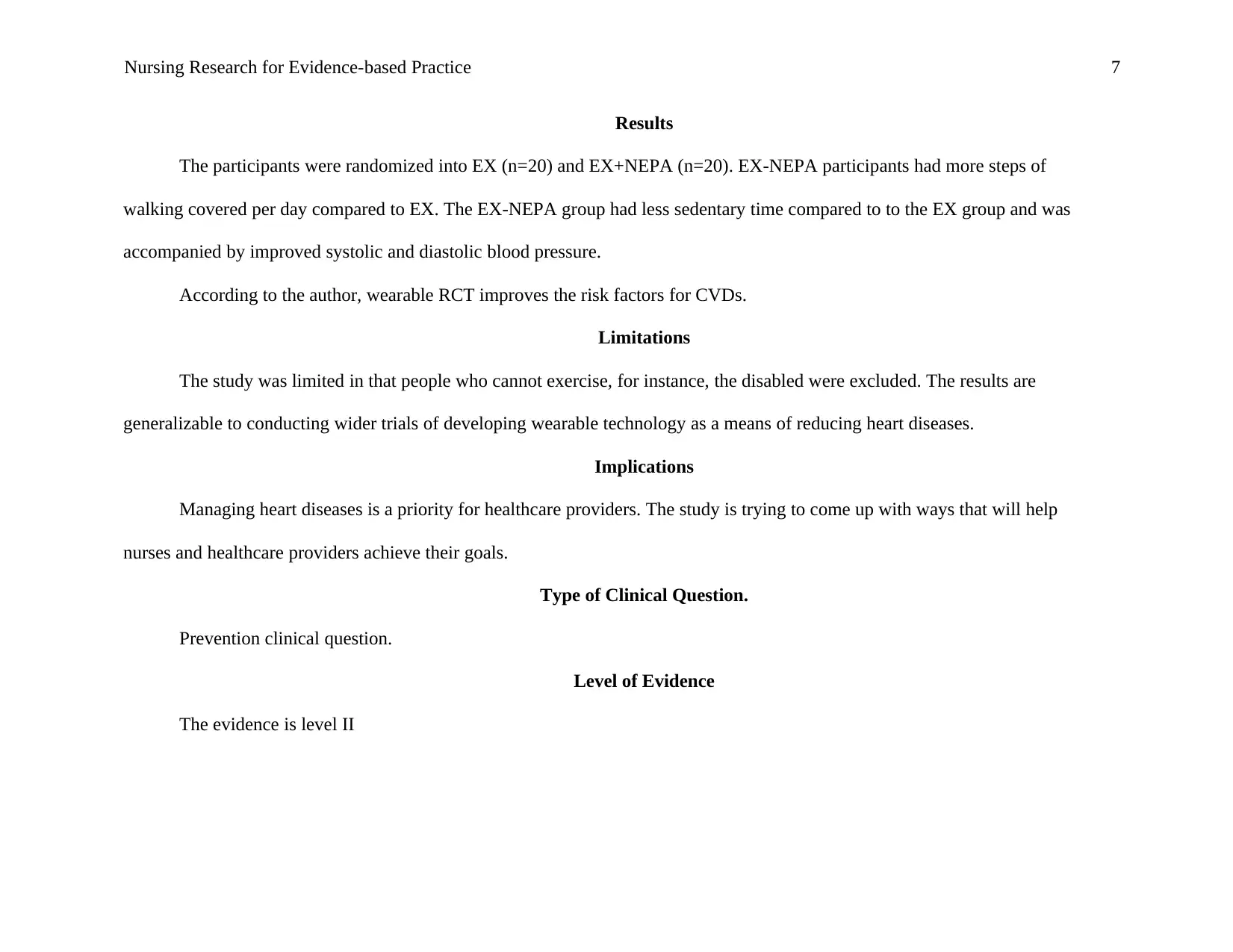
Nursing Research for Evidence-based Practice 7
Results
The participants were randomized into EX (n=20) and EX+NEPA (n=20). EX-NEPA participants had more steps of
walking covered per day compared to EX. The EX-NEPA group had less sedentary time compared to to the EX group and was
accompanied by improved systolic and diastolic blood pressure.
According to the author, wearable RCT improves the risk factors for CVDs.
Limitations
The study was limited in that people who cannot exercise, for instance, the disabled were excluded. The results are
generalizable to conducting wider trials of developing wearable technology as a means of reducing heart diseases.
Implications
Managing heart diseases is a priority for healthcare providers. The study is trying to come up with ways that will help
nurses and healthcare providers achieve their goals.
Type of Clinical Question.
Prevention clinical question.
Level of Evidence
The evidence is level II
Results
The participants were randomized into EX (n=20) and EX+NEPA (n=20). EX-NEPA participants had more steps of
walking covered per day compared to EX. The EX-NEPA group had less sedentary time compared to to the EX group and was
accompanied by improved systolic and diastolic blood pressure.
According to the author, wearable RCT improves the risk factors for CVDs.
Limitations
The study was limited in that people who cannot exercise, for instance, the disabled were excluded. The results are
generalizable to conducting wider trials of developing wearable technology as a means of reducing heart diseases.
Implications
Managing heart diseases is a priority for healthcare providers. The study is trying to come up with ways that will help
nurses and healthcare providers achieve their goals.
Type of Clinical Question.
Prevention clinical question.
Level of Evidence
The evidence is level II
Paraphrase This Document
Need a fresh take? Get an instant paraphrase of this document with our AI Paraphraser
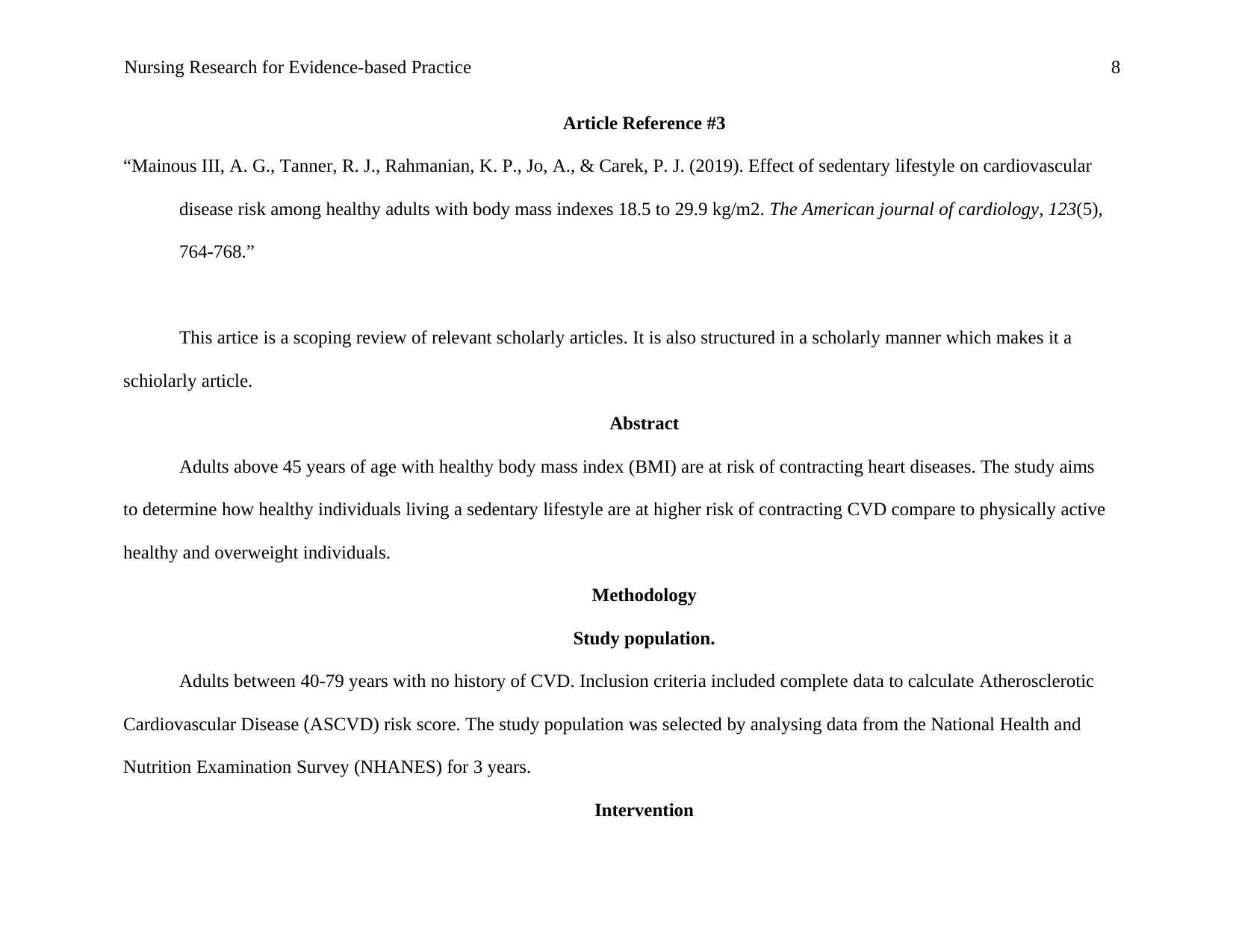
Nursing Research for Evidence-based Practice 8
Article Reference #3
“Mainous III, A. G., Tanner, R. J., Rahmanian, K. P., Jo, A., & Carek, P. J. (2019). Effect of sedentary lifestyle on cardiovascular
disease risk among healthy adults with body mass indexes 18.5 to 29.9 kg/m2. The American journal of cardiology, 123(5),
764-768.”
This artice is a scoping review of relevant scholarly articles. It is also structured in a scholarly manner which makes it a
schiolarly article.
Abstract
Adults above 45 years of age with healthy body mass index (BMI) are at risk of contracting heart diseases. The study aims
to determine how healthy individuals living a sedentary lifestyle are at higher risk of contracting CVD compare to physically active
healthy and overweight individuals.
Methodology
Study population.
Adults between 40-79 years with no history of CVD. Inclusion criteria included complete data to calculate Atherosclerotic
Cardiovascular Disease (ASCVD) risk score. The study population was selected by analysing data from the National Health and
Nutrition Examination Survey (NHANES) for 3 years.
Intervention
Article Reference #3
“Mainous III, A. G., Tanner, R. J., Rahmanian, K. P., Jo, A., & Carek, P. J. (2019). Effect of sedentary lifestyle on cardiovascular
disease risk among healthy adults with body mass indexes 18.5 to 29.9 kg/m2. The American journal of cardiology, 123(5),
764-768.”
This artice is a scoping review of relevant scholarly articles. It is also structured in a scholarly manner which makes it a
schiolarly article.
Abstract
Adults above 45 years of age with healthy body mass index (BMI) are at risk of contracting heart diseases. The study aims
to determine how healthy individuals living a sedentary lifestyle are at higher risk of contracting CVD compare to physically active
healthy and overweight individuals.
Methodology
Study population.
Adults between 40-79 years with no history of CVD. Inclusion criteria included complete data to calculate Atherosclerotic
Cardiovascular Disease (ASCVD) risk score. The study population was selected by analysing data from the National Health and
Nutrition Examination Survey (NHANES) for 3 years.
Intervention
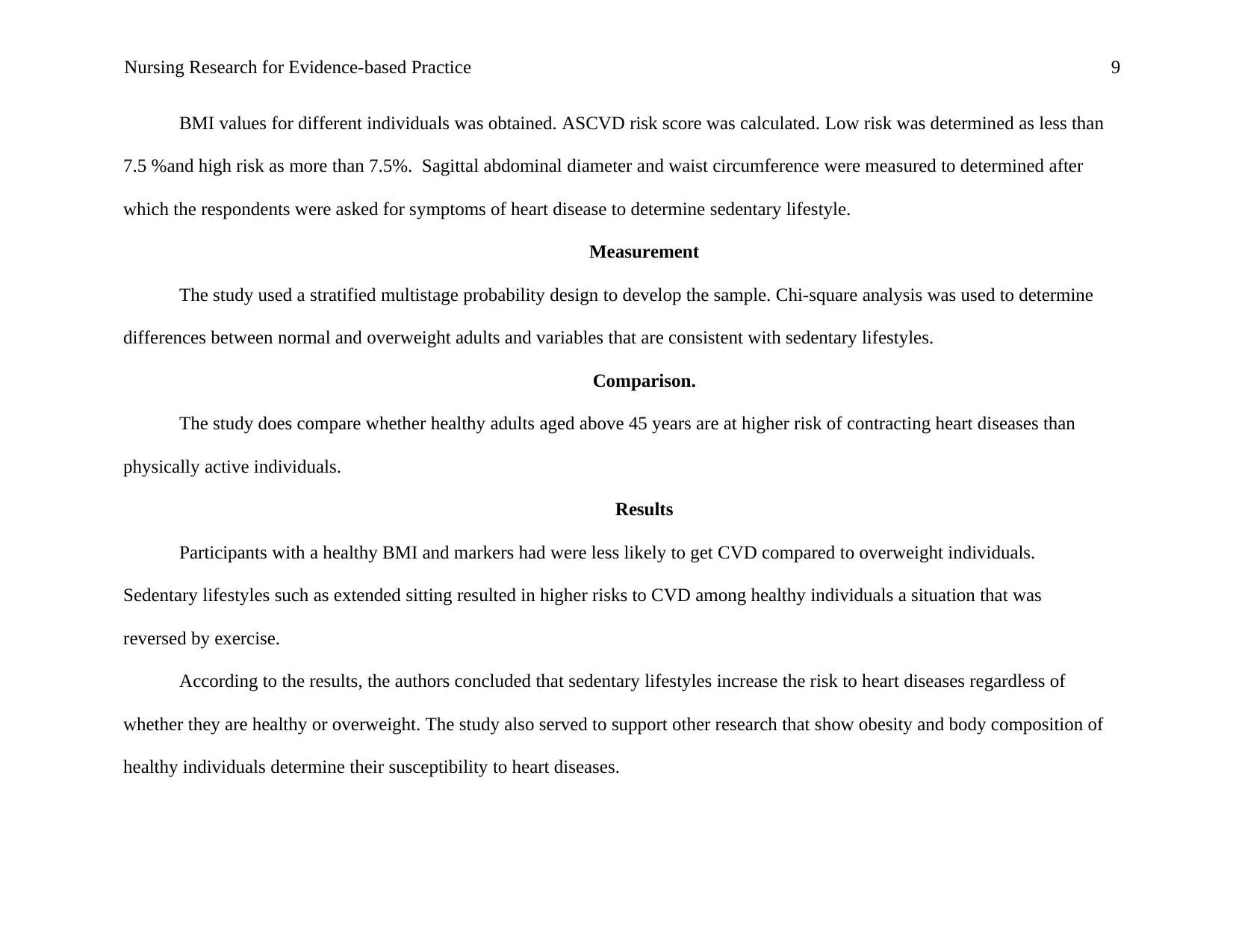
Nursing Research for Evidence-based Practice 9
BMI values for different individuals was obtained. ASCVD risk score was calculated. Low risk was determined as less than
7.5 %and high risk as more than 7.5%. Sagittal abdominal diameter and waist circumference were measured to determined after
which the respondents were asked for symptoms of heart disease to determine sedentary lifestyle.
Measurement
The study used a stratified multistage probability design to develop the sample. Chi-square analysis was used to determine
differences between normal and overweight adults and variables that are consistent with sedentary lifestyles.
Comparison.
The study does compare whether healthy adults aged above 45 years are at higher risk of contracting heart diseases than
physically active individuals.
Results
Participants with a healthy BMI and markers had were less likely to get CVD compared to overweight individuals.
Sedentary lifestyles such as extended sitting resulted in higher risks to CVD among healthy individuals a situation that was
reversed by exercise.
According to the results, the authors concluded that sedentary lifestyles increase the risk to heart diseases regardless of
whether they are healthy or overweight. The study also served to support other research that show obesity and body composition of
healthy individuals determine their susceptibility to heart diseases.
BMI values for different individuals was obtained. ASCVD risk score was calculated. Low risk was determined as less than
7.5 %and high risk as more than 7.5%. Sagittal abdominal diameter and waist circumference were measured to determined after
which the respondents were asked for symptoms of heart disease to determine sedentary lifestyle.
Measurement
The study used a stratified multistage probability design to develop the sample. Chi-square analysis was used to determine
differences between normal and overweight adults and variables that are consistent with sedentary lifestyles.
Comparison.
The study does compare whether healthy adults aged above 45 years are at higher risk of contracting heart diseases than
physically active individuals.
Results
Participants with a healthy BMI and markers had were less likely to get CVD compared to overweight individuals.
Sedentary lifestyles such as extended sitting resulted in higher risks to CVD among healthy individuals a situation that was
reversed by exercise.
According to the results, the authors concluded that sedentary lifestyles increase the risk to heart diseases regardless of
whether they are healthy or overweight. The study also served to support other research that show obesity and body composition of
healthy individuals determine their susceptibility to heart diseases.
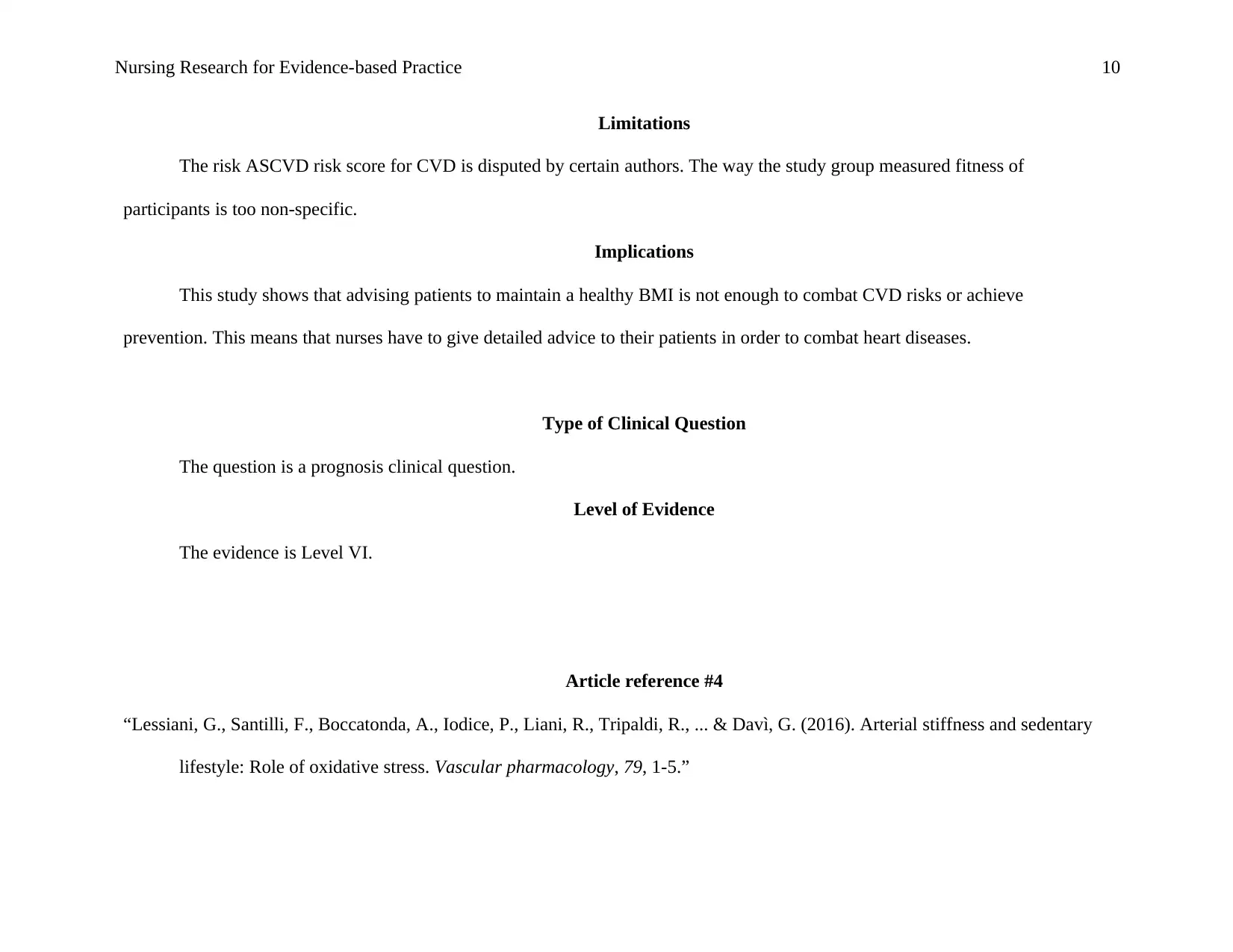
Nursing Research for Evidence-based Practice 10
Limitations
The risk ASCVD risk score for CVD is disputed by certain authors. The way the study group measured fitness of
participants is too non-specific.
Implications
This study shows that advising patients to maintain a healthy BMI is not enough to combat CVD risks or achieve
prevention. This means that nurses have to give detailed advice to their patients in order to combat heart diseases.
Type of Clinical Question
The question is a prognosis clinical question.
Level of Evidence
The evidence is Level VI.
Article reference #4
“Lessiani, G., Santilli, F., Boccatonda, A., Iodice, P., Liani, R., Tripaldi, R., ... & Davì, G. (2016). Arterial stiffness and sedentary
lifestyle: Role of oxidative stress. Vascular pharmacology, 79, 1-5.”
Limitations
The risk ASCVD risk score for CVD is disputed by certain authors. The way the study group measured fitness of
participants is too non-specific.
Implications
This study shows that advising patients to maintain a healthy BMI is not enough to combat CVD risks or achieve
prevention. This means that nurses have to give detailed advice to their patients in order to combat heart diseases.
Type of Clinical Question
The question is a prognosis clinical question.
Level of Evidence
The evidence is Level VI.
Article reference #4
“Lessiani, G., Santilli, F., Boccatonda, A., Iodice, P., Liani, R., Tripaldi, R., ... & Davì, G. (2016). Arterial stiffness and sedentary
lifestyle: Role of oxidative stress. Vascular pharmacology, 79, 1-5.”
Secure Best Marks with AI Grader
Need help grading? Try our AI Grader for instant feedback on your assignments.
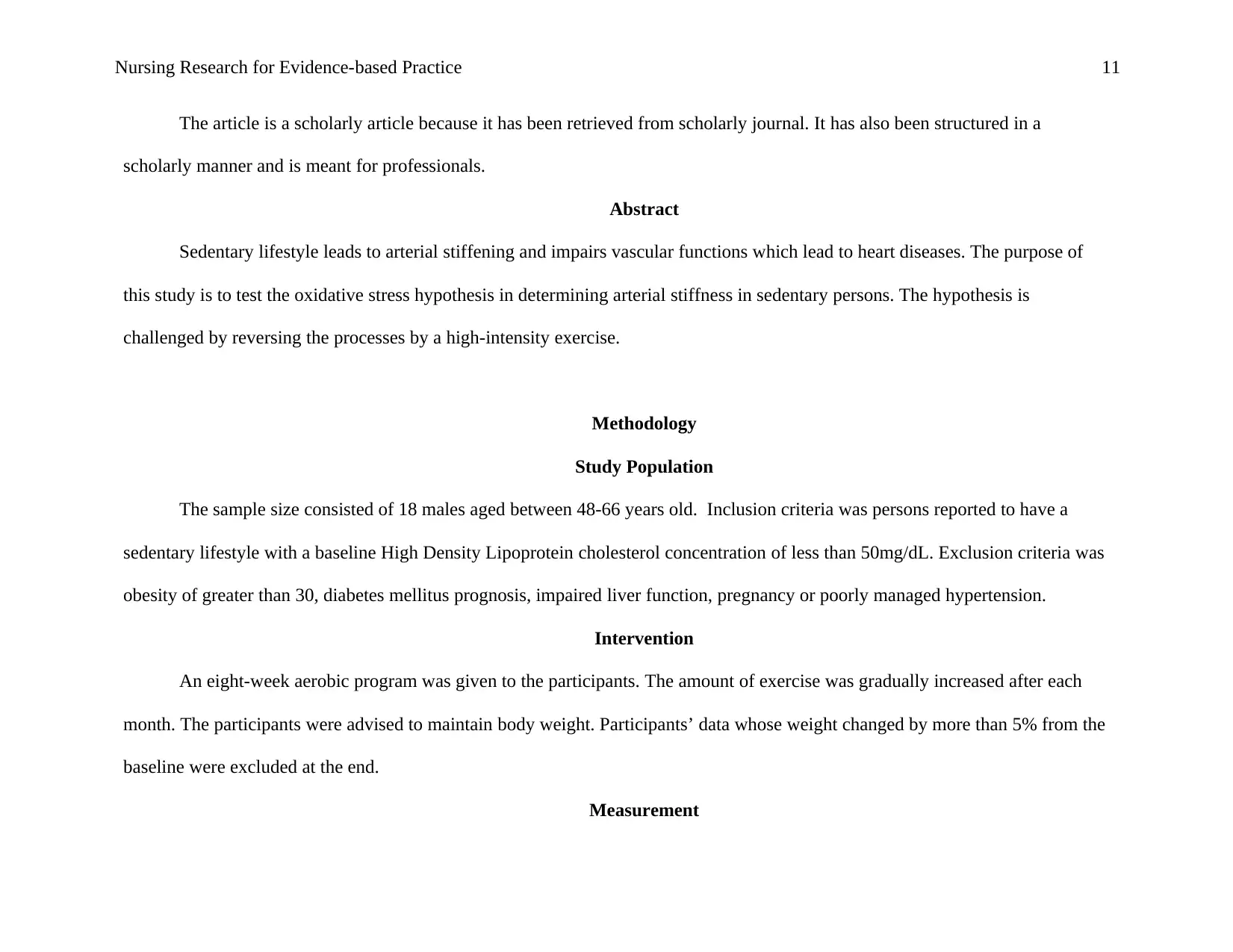
Nursing Research for Evidence-based Practice 11
The article is a scholarly article because it has been retrieved from scholarly journal. It has also been structured in a
scholarly manner and is meant for professionals.
Abstract
Sedentary lifestyle leads to arterial stiffening and impairs vascular functions which lead to heart diseases. The purpose of
this study is to test the oxidative stress hypothesis in determining arterial stiffness in sedentary persons. The hypothesis is
challenged by reversing the processes by a high-intensity exercise.
Methodology
Study Population
The sample size consisted of 18 males aged between 48-66 years old. Inclusion criteria was persons reported to have a
sedentary lifestyle with a baseline High Density Lipoprotein cholesterol concentration of less than 50mg/dL. Exclusion criteria was
obesity of greater than 30, diabetes mellitus prognosis, impaired liver function, pregnancy or poorly managed hypertension.
Intervention
An eight-week aerobic program was given to the participants. The amount of exercise was gradually increased after each
month. The participants were advised to maintain body weight. Participants’ data whose weight changed by more than 5% from the
baseline were excluded at the end.
Measurement
The article is a scholarly article because it has been retrieved from scholarly journal. It has also been structured in a
scholarly manner and is meant for professionals.
Abstract
Sedentary lifestyle leads to arterial stiffening and impairs vascular functions which lead to heart diseases. The purpose of
this study is to test the oxidative stress hypothesis in determining arterial stiffness in sedentary persons. The hypothesis is
challenged by reversing the processes by a high-intensity exercise.
Methodology
Study Population
The sample size consisted of 18 males aged between 48-66 years old. Inclusion criteria was persons reported to have a
sedentary lifestyle with a baseline High Density Lipoprotein cholesterol concentration of less than 50mg/dL. Exclusion criteria was
obesity of greater than 30, diabetes mellitus prognosis, impaired liver function, pregnancy or poorly managed hypertension.
Intervention
An eight-week aerobic program was given to the participants. The amount of exercise was gradually increased after each
month. The participants were advised to maintain body weight. Participants’ data whose weight changed by more than 5% from the
baseline were excluded at the end.
Measurement
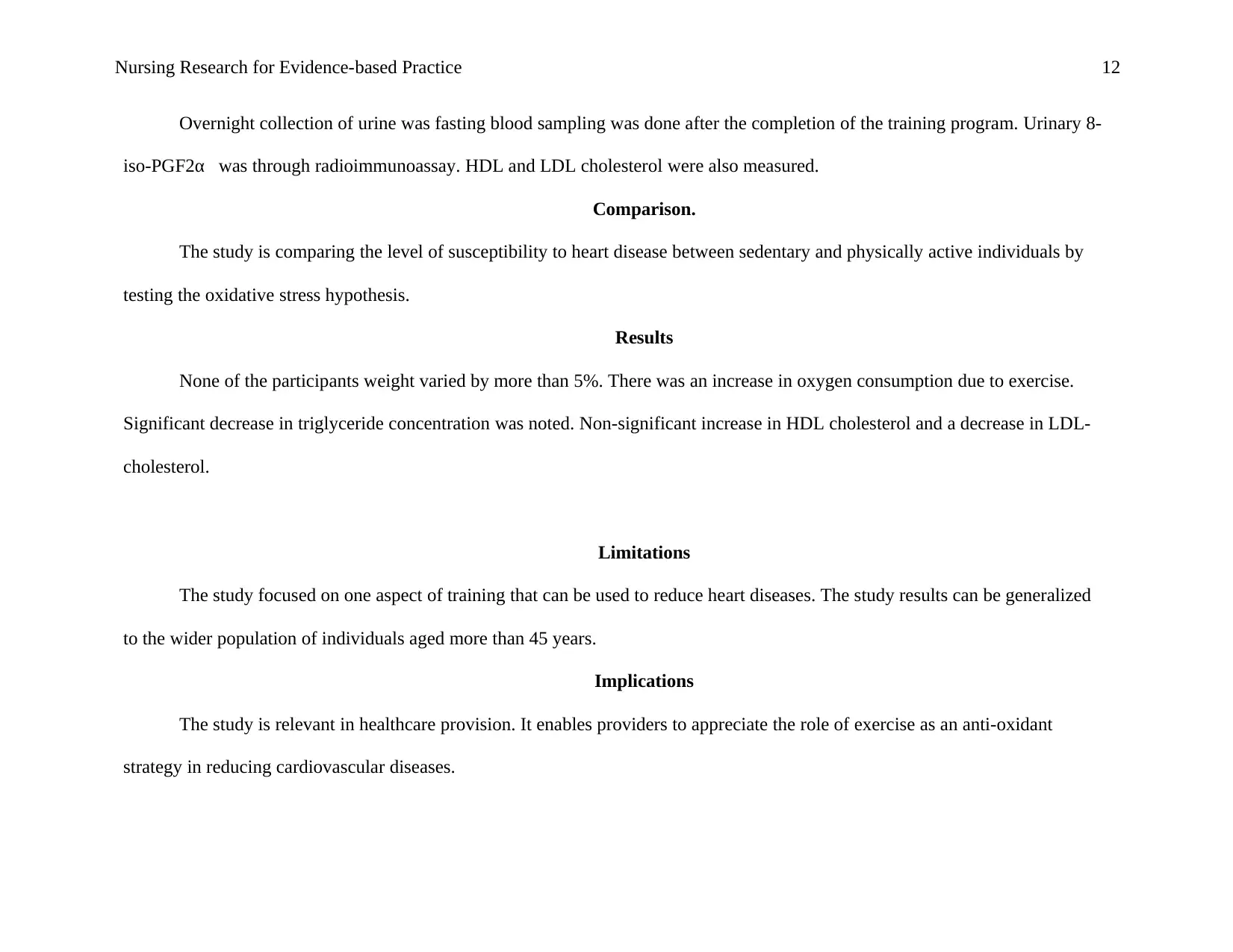
Nursing Research for Evidence-based Practice 12
Overnight collection of urine was fasting blood sampling was done after the completion of the training program. Urinary 8-
iso-PGF2α was through radioimmunoassay. HDL and LDL cholesterol were also measured.
Comparison.
The study is comparing the level of susceptibility to heart disease between sedentary and physically active individuals by
testing the oxidative stress hypothesis.
Results
None of the participants weight varied by more than 5%. There was an increase in oxygen consumption due to exercise.
Significant decrease in triglyceride concentration was noted. Non-significant increase in HDL cholesterol and a decrease in LDL-
cholesterol.
Limitations
The study focused on one aspect of training that can be used to reduce heart diseases. The study results can be generalized
to the wider population of individuals aged more than 45 years.
Implications
The study is relevant in healthcare provision. It enables providers to appreciate the role of exercise as an anti-oxidant
strategy in reducing cardiovascular diseases.
Overnight collection of urine was fasting blood sampling was done after the completion of the training program. Urinary 8-
iso-PGF2α was through radioimmunoassay. HDL and LDL cholesterol were also measured.
Comparison.
The study is comparing the level of susceptibility to heart disease between sedentary and physically active individuals by
testing the oxidative stress hypothesis.
Results
None of the participants weight varied by more than 5%. There was an increase in oxygen consumption due to exercise.
Significant decrease in triglyceride concentration was noted. Non-significant increase in HDL cholesterol and a decrease in LDL-
cholesterol.
Limitations
The study focused on one aspect of training that can be used to reduce heart diseases. The study results can be generalized
to the wider population of individuals aged more than 45 years.
Implications
The study is relevant in healthcare provision. It enables providers to appreciate the role of exercise as an anti-oxidant
strategy in reducing cardiovascular diseases.
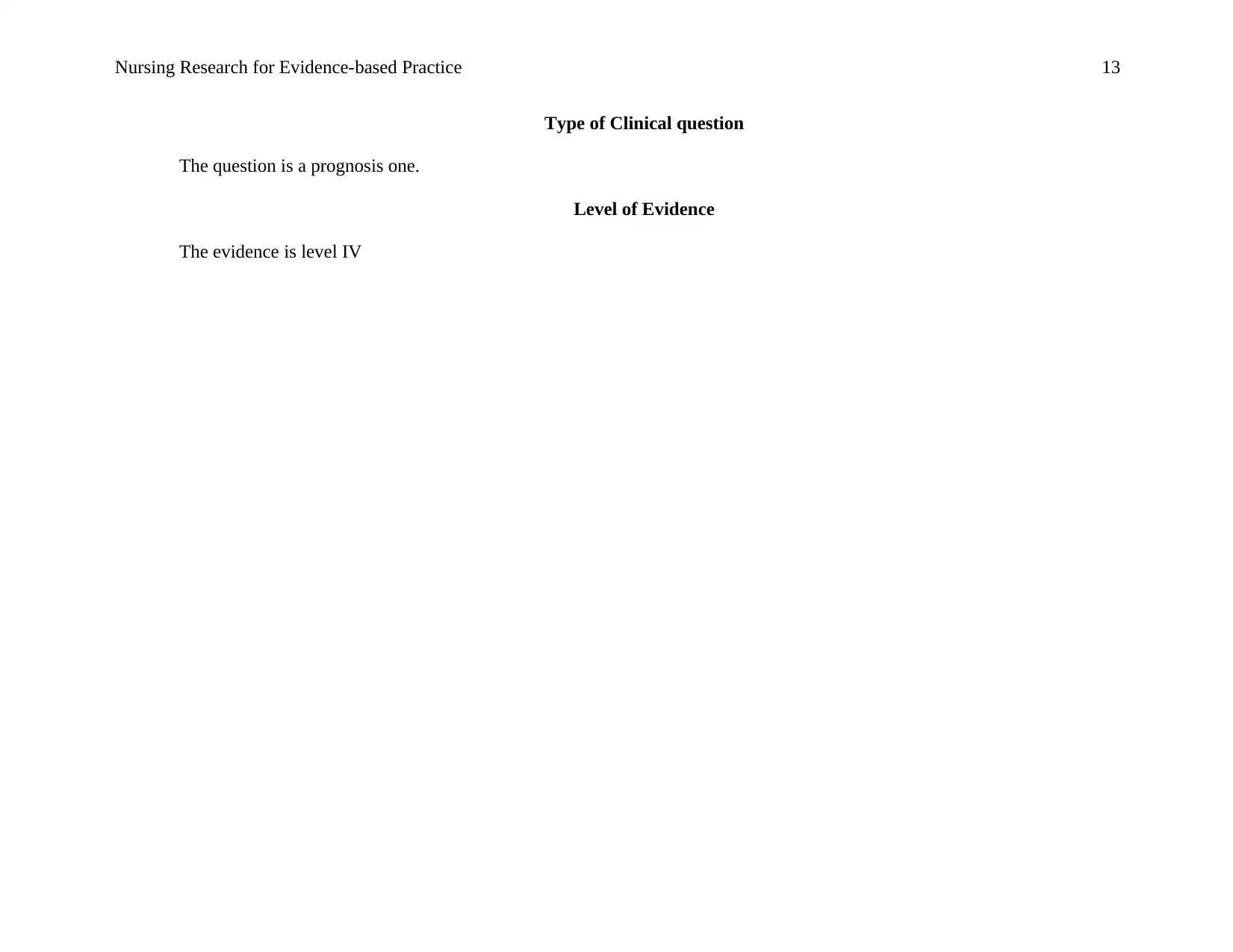
Nursing Research for Evidence-based Practice 13
Type of Clinical question
The question is a prognosis one.
Level of Evidence
The evidence is level IV
Type of Clinical question
The question is a prognosis one.
Level of Evidence
The evidence is level IV
Paraphrase This Document
Need a fresh take? Get an instant paraphrase of this document with our AI Paraphraser
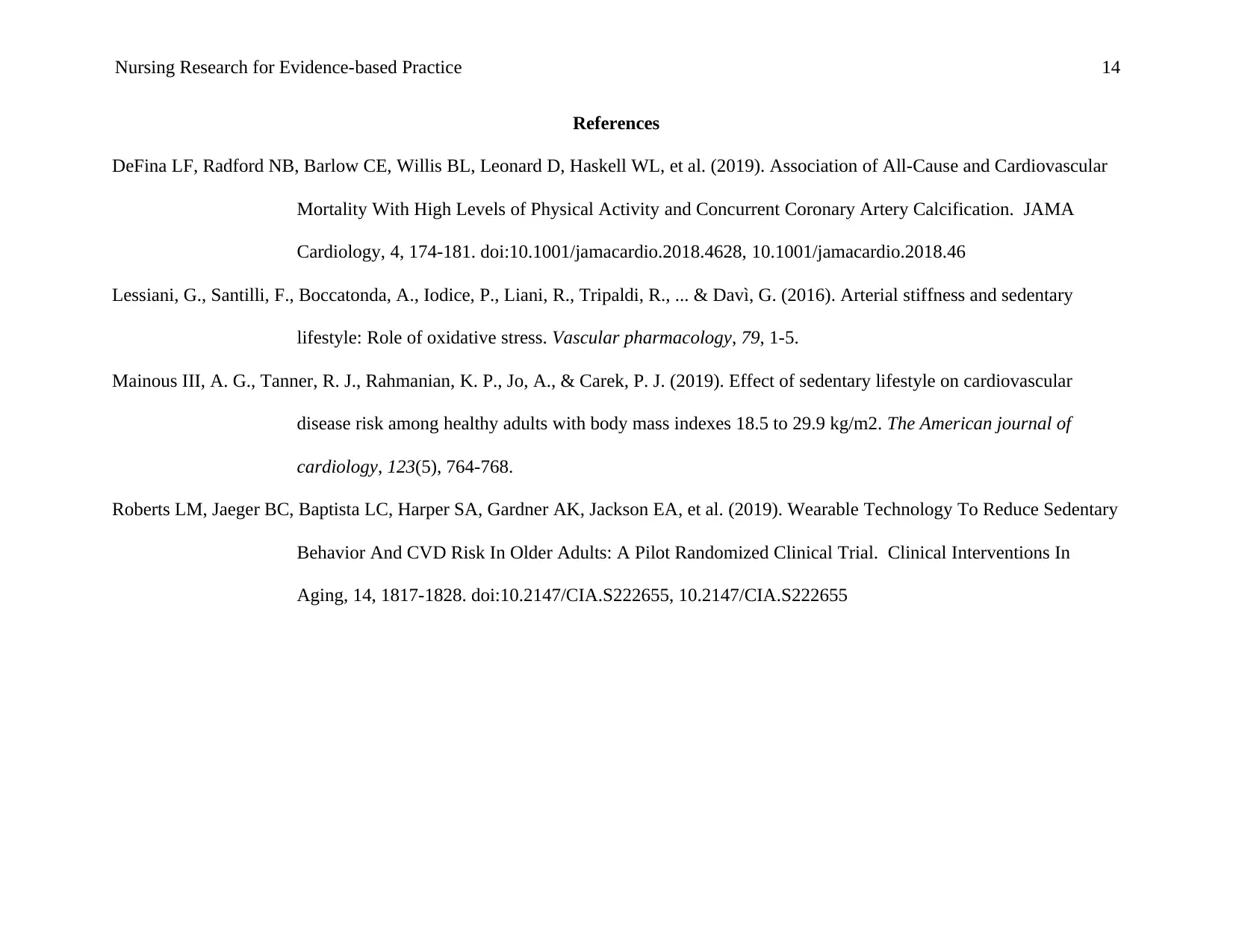
Nursing Research for Evidence-based Practice 14
References
DeFina LF, Radford NB, Barlow CE, Willis BL, Leonard D, Haskell WL, et al. (2019). Association of All-Cause and Cardiovascular
Mortality With High Levels of Physical Activity and Concurrent Coronary Artery Calcification. JAMA
Cardiology, 4, 174-181. doi:10.1001/jamacardio.2018.4628, 10.1001/jamacardio.2018.46
Lessiani, G., Santilli, F., Boccatonda, A., Iodice, P., Liani, R., Tripaldi, R., ... & Davì, G. (2016). Arterial stiffness and sedentary
lifestyle: Role of oxidative stress. Vascular pharmacology, 79, 1-5.
Mainous III, A. G., Tanner, R. J., Rahmanian, K. P., Jo, A., & Carek, P. J. (2019). Effect of sedentary lifestyle on cardiovascular
disease risk among healthy adults with body mass indexes 18.5 to 29.9 kg/m2. The American journal of
cardiology, 123(5), 764-768.
Roberts LM, Jaeger BC, Baptista LC, Harper SA, Gardner AK, Jackson EA, et al. (2019). Wearable Technology To Reduce Sedentary
Behavior And CVD Risk In Older Adults: A Pilot Randomized Clinical Trial. Clinical Interventions In
Aging, 14, 1817-1828. doi:10.2147/CIA.S222655, 10.2147/CIA.S222655
References
DeFina LF, Radford NB, Barlow CE, Willis BL, Leonard D, Haskell WL, et al. (2019). Association of All-Cause and Cardiovascular
Mortality With High Levels of Physical Activity and Concurrent Coronary Artery Calcification. JAMA
Cardiology, 4, 174-181. doi:10.1001/jamacardio.2018.4628, 10.1001/jamacardio.2018.46
Lessiani, G., Santilli, F., Boccatonda, A., Iodice, P., Liani, R., Tripaldi, R., ... & Davì, G. (2016). Arterial stiffness and sedentary
lifestyle: Role of oxidative stress. Vascular pharmacology, 79, 1-5.
Mainous III, A. G., Tanner, R. J., Rahmanian, K. P., Jo, A., & Carek, P. J. (2019). Effect of sedentary lifestyle on cardiovascular
disease risk among healthy adults with body mass indexes 18.5 to 29.9 kg/m2. The American journal of
cardiology, 123(5), 764-768.
Roberts LM, Jaeger BC, Baptista LC, Harper SA, Gardner AK, Jackson EA, et al. (2019). Wearable Technology To Reduce Sedentary
Behavior And CVD Risk In Older Adults: A Pilot Randomized Clinical Trial. Clinical Interventions In
Aging, 14, 1817-1828. doi:10.2147/CIA.S222655, 10.2147/CIA.S222655
1 out of 14
Related Documents
Your All-in-One AI-Powered Toolkit for Academic Success.
+13062052269
info@desklib.com
Available 24*7 on WhatsApp / Email
![[object Object]](/_next/static/media/star-bottom.7253800d.svg)
Unlock your academic potential
© 2024 | Zucol Services PVT LTD | All rights reserved.





